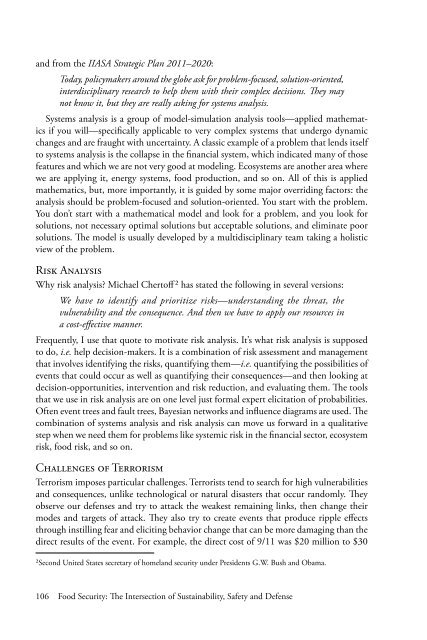Food Security - National Agricultural Biotechnology Council ...
Food Security - National Agricultural Biotechnology Council ...
Food Security - National Agricultural Biotechnology Council ...
- No tags were found...
You also want an ePaper? Increase the reach of your titles
YUMPU automatically turns print PDFs into web optimized ePapers that Google loves.
and from the IIASA Strategic Plan 2011–2020:Today, policymakers around the globe ask for problem-focused, solution-oriented,interdisciplinary research to help them with their complex decisions. They maynot know it, but they are really asking for systems analysis.Systems analysis is a group of model-simulation analysis tools—applied mathematicsif you will—specifically applicable to very complex systems that undergo dynamicchanges and are fraught with uncertainty. A classic example of a problem that lends itselfto systems analysis is the collapse in the financial system, which indicated many of thosefeatures and which we are not very good at modeling. Ecosystems are another area wherewe are applying it, energy systems, food production, and so on. All of this is appliedmathematics, but, more importantly, it is guided by some major overriding factors: theanalysis should be problem-focused and solution-oriented. You start with the problem.You don’t start with a mathematical model and look for a problem, and you look forsolutions, not necessary optimal solutions but acceptable solutions, and eliminate poorsolutions. The model is usually developed by a multidisciplinary team taking a holisticview of the problem.Risk AnalysisWhy risk analysis? Michael Chertoff 2 has stated the following in several versions:We have to identify and prioritize risks—understanding the threat, thevulnerability and the consequence. And then we have to apply our resources ina cost-effective manner.Frequently, I use that quote to motivate risk analysis. It’s what risk analysis is supposedto do, i.e. help decision-makers. It is a combination of risk assessment and managementthat involves identifying the risks, quantifying them—i.e. quantifying the possibilities ofevents that could occur as well as quantifying their consequences—and then looking atdecision-opportunities, intervention and risk reduction, and evaluating them. The toolsthat we use in risk analysis are on one level just formal expert elicitation of probabilities.Often event trees and fault trees, Bayesian networks and influence diagrams are used. Thecombination of systems analysis and risk analysis can move us forward in a qualitativestep when we need them for problems like systemic risk in the financial sector, ecosystemrisk, food risk, and so on.Challenges of TerrorismTerrorism imposes particular challenges. Terrorists tend to search for high vulnerabilitiesand consequences, unlike technological or natural disasters that occur randomly. Theyobserve our defenses and try to attack the weakest remaining links, then change theirmodes and targets of attack. They also try to create events that produce ripple effectsthrough instilling fear and eliciting behavior change that can be more damaging than thedirect results of the event. For example, the direct cost of 9/11 was $20 million to $302Second United States secretary of homeland security under Presidents G.W. Bush and Obama.106 <strong>Food</strong> <strong>Security</strong>: The Intersection of Sustainability, Safety and Defense















